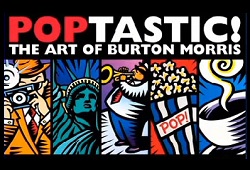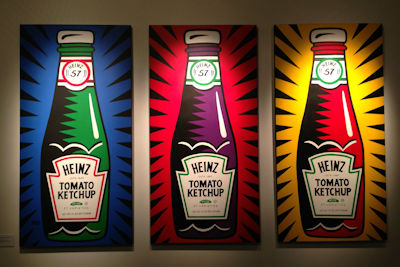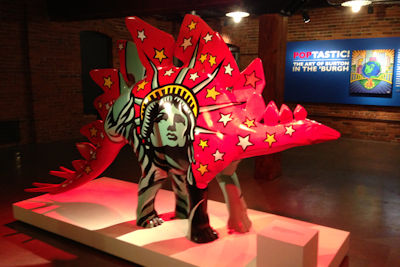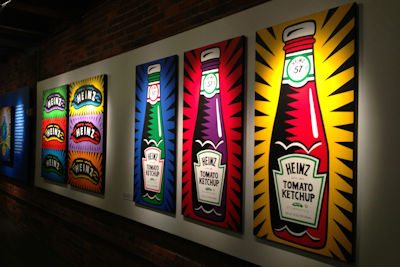
Andy Warhol is arguably the most famous artist to emerge from Pittsburgh, Pennsylvania, as well as a leading figure in the Pop Art movement that swept the nation in the 1960s and still remains as one of the dominant artistic styles of our times. From classic comic book superheroes to modern day advertising campaigns, Pop Art has helped define contemporary culture as much as anything else.
Although Warhol was at the forefront of the Pop Art movement from its inception, he is not the only Steel City native to find success within the field as another Pittsburgh artist has likewise made an indelible mark within the realm of Pop Art – Burton Morris.
“As a child, I was always attracted to the bright colors and energetic shapes of comic book art and cartoons,” Morris explains in the opening pages of Pop!, a small coffee table collection of his artwork published in 2007. “Every day I would spend countless hours drawing, trying to teach myself about the fundamentals of art. My parents encouraged my talents and sent me to art classes close to our home at the Carnegie International Museum of Art in Pittsburgh. There, I was first exposed to great works of art from all over the world.”
It wasn’t long afterwards that the world was exposed to the emerging talent of Burton Morris, and the Senator John Heinz History Center honored one of the Steel City’s premier artists with its Poptastic! The Art of Burton Morris exhibit, which was on display from September 2013 through February 2014. The History Center’s fourth floor was in effect turned into a Pop Art Gallery for the occasion, with its walls covered in a full array of paintings and graphic illustrations that ran the gamut of Morris’ ongoing career.
In many ways, the early segments of Burton Morris’ career were a series of “fifteen minutes of fame” – to borrow a phrase from Warhol – that quickly erupted into long-term notoriety. In 1993, for instance, Morris was selected to represent Pennsylvania for an Absolut Vodka advertising campaign that featured artwork by one artist from every state in the country appearing in bi-weekly editions of USA Today.
While Morris’ Pop Art rendering of an Absolut Vodka bottle raised his awareness within the art world, his next “big break” was even larger in scale. Burton Morris’ sister Stacy, who was living in California, convinced various boutiques in her neighborhood to carry a collection of T-shirts designed by her brother. Kevin Bright, co-producer of NBC’s mega-hit Friends, purchased one of them for the character of Ross Geller to wear on the show. Morris was later invited on-set, and his paintings became permanent fixtures on the walls of the fictional Central Perk coffee shop that the Friends gang regularly visited.
Having now fully established himself as one of the leading Pop Art creators of his generation – and becoming part of pop culture itself with his artwork being displayed on the number one television sitcom – Burton Morris’ career went global. Morris was chosen as the official artist for World Cup Soccer in 1998 and again in 2010, for instance, while the International Olympic Committee contracted him to create thirty-six paintings that captured the spirit of the 2004 Summer Olympics in Athens, Greece.
The Academy of Motion Picture Arts and Sciences likewise commissioned Burton Morris for their 76th Annual Academy Awards. “We asked Burton to come up with an image to re-energize the Oscars and to bring back some of the glitz, glamour, and flash of Hollywood,” executive director Bruce Davis explained. “His artwork is youthful and fun, and it captures the excitement that surrounds the Academy Awards.”
The main piece – entitled “Poparazzi” – features a suit-wearing photographer holding his camera with an image of the Oscar Trophy in the foreground. The artwork was later re-imagined by Burton Morris with the assistance of the Carnegie Mellon University Entertainment Technology Center into an interactive “Digital Poparazzi.” Instead of a drawing, the photographer is now comprised of smaller images that are actual photographs. A nearby camera flashes whenever someone walks by the piece, and the resulting picture is added to the image of the photographer, replacing the oldest photo and becoming part of the artwork itself in the process.
“No matter where his art has taken him, Pittsburgh has remained a creative muse for Burton Morris,” the Poptastic! exhibit at the Heinz History Center explains. “Though he now makes his home on the West Coast, Morris continues to return to Pittsburgh, and organizations from the region still seek his eye and hand to create art that brands their events or preserves special moments. Over the past two decades, Morris’ art has reimagined the city, casting a fresh, energetic vision of our region to the world.”
Poptastic! included a healthy dose of Burton Morris’ Pittsburgh-themed artwork in addition to his national and international pieces, including illustrations created for the 2006 Major League Baseball All-Star Game held at PNC Park, the fiftieth anniversary of the 1960 World Series that features former Pirate Bill Mazeroski, and drawings of various characters from Mister Rogers’ Neighborhood for the twenty-fifth anniversary of the classic children’s television show.
The Steel City is likewise represented in another of Burton Morris’ artistic endeavors, a series of “night stand portraits” that feature items one might find on the bedside table of famous celebrities, artists, and sports heroes. The project began with the “Andy Warhol Nightstand,” which Morris painted numerous times, before taking on a life of its own. The Heinz History Center spotlighted three of these unique portraits – the aforementioned Warhol, Fred Rogers, and hockey legend Mario Lemieux.
“How very lucky for art lovers everywhere that Burton Morris abandoned his hope of drawing comic books and created his own style,” Stan Lee, the legendary former editor of Marvel Comics, writes in the introduction of Pop! “No, even more than his own style – his own shining world, a world of painting like no other, a pop culture world of color and composition and cheer which he himself has created and which brings unimaginable joy to countless viewers around the globe.”
Not to mention the thousands of residents who live in the Steel City as well.
Anthony Letizia





